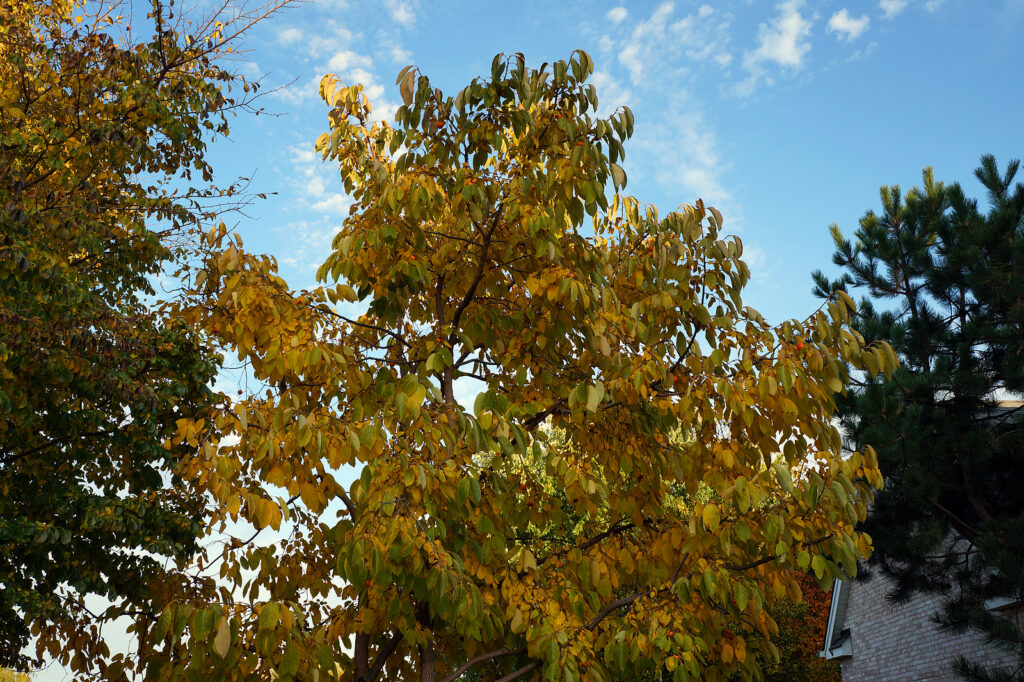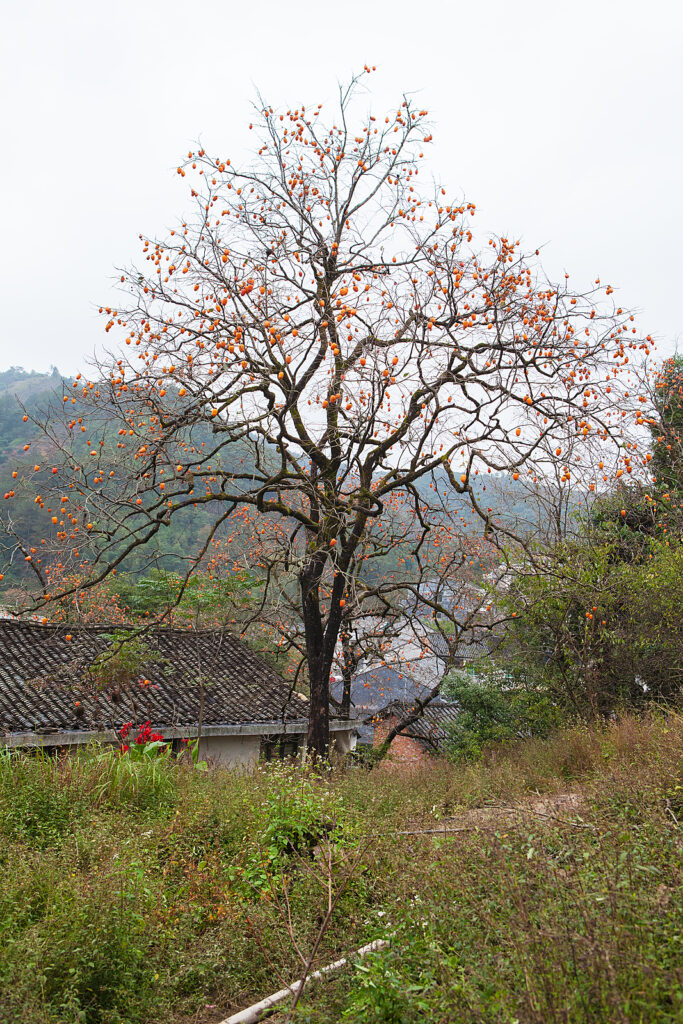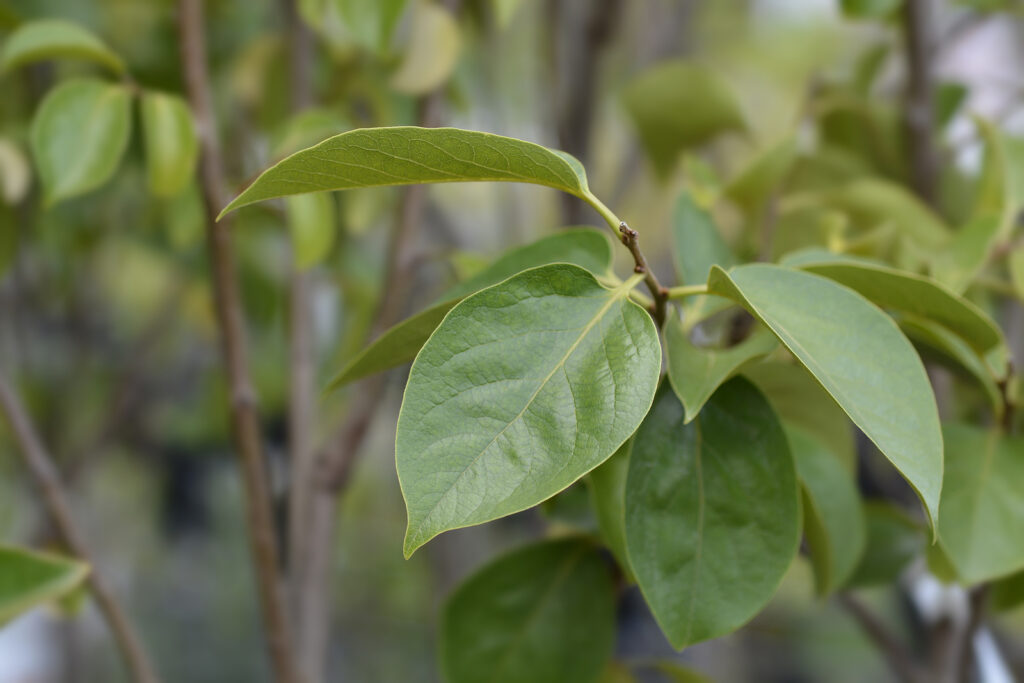Diospyros–commonly called persimmon–is grown for its attractive, symmetrical habit, fall foliage color, and heart-shaped fleshy fruit. There are two main Diospyros varieties commonly grown in gardens, Japanese or Chinese persimmons (Asian persimmons), also called kaki, and American persimmons.
Asian persimmons grow to 30 feet tall with a wide-spreading branch pattern. They are one of the best fruit trees for ornamental use. There are several well-known cultivars of Asian persimmons–‘Fuyu’ and ‘Hachiya’ are two. The fruits are orange and vary from very sweet to astringent.
American persimmons are similar to Asian persimmons in habit and ornamental use, but can sucker from the roots making the tree somewhat problematic. The fruit is very astringent until soft-ripe then it is sweet.
Persimmon fall foliage color vsries from brilliant to subdued shades of yellow, gold, and red. The brilliant orange fruits persist on the trees long after the leaves drop in winter.
Diospyros is a genus of about 475 species of deciduous or evergreen trees and shrubs found in tropical, sub-tropical, and warm temperature regions around the world.

Get to know Diospyros
- Plant type: Deciduous or evergreen trees and shrubs
- Growing zones and range: Zones 4 to 9 depending on the variety
- Hardiness: Chinese persimons are hardy to Zone 7; American persimmons are hardy to Zone 4.
- Height and width: To 70 feet (20m) tall and 35 feet (11m) wide
- Growth rate: Large oval crown
- Form and habit: Attractive habit
- Foliage: Bold, alternate, lance-shaped to broadly ovate, simple often glossy leaves (sometimes with heart-shaped bases); gray-brown bark fissured into checkered pattern
- Flowers: Bell- or urn-shaped, small blueberry-like male and female flowers are usually borne on separate plants, on the previous year’s wood
- Fruits: Fleshy, edible fruits
- Bloom time: Spring
- Uses: Specimen trees, espalier on warm, sunny wall, landscape
- Garden companions:
- Common name: Persimmon
- Botanical name: Diospyros
- Family name: Ebenaceae
- Origin: Forests of eastern and central North America and Asia
Where to plant Diospyros
- Plant Diospyros in full sun, preferably sheltered from cold, drying winds and late frosts.
- Plant Diospyros in deep, fertile, well-drained, loamy soil.
When to plant Diospyros
- Plant container-grown Diospyros in the garden in spring or autumn.
- Sow Diospyros seed in containers in an open frame as soon as ripe.
Planting and spacing Diospyros
- Plant Diospyros 35 feet (11m) apart.
- Diospyros may be difficult in transplanting; choose small balled-and-burlapped or container-grown trees.
- Plant Diospyros deep to accommodate their long roots.

How to water and feed Diospyros
- Give Diospyros regular to moderate water.
- Feed Diospyros with an all-purpose organic fertilizer in spring.
How to care for Diospyros
- Diospyros is a tough survivor that adapts to urban stress.
- Diospyros rarely needs pruning, but what little pruning is needed should be done in winter.
Diospyros pests and diseases
- Diospyros are susceptible to attacks by scale insects, leaf rollers, and mealybugs.
- Fruit rot, wood rot, anthracnose, Acremonium wilt, powdery mildew, and a variety of fungal spots and blights are common.
- Leaf spot is troublesome in the South.

Diospyros propagation
- Sow seed in containers as soon as ripe.
- Graft Diospyros cultivars in winter.
Diospyros varieties to grow
- Diospyros kaki, Chinese persimmon, Japanese persimmon, Kaki, spreading, deciduous tree with oval, glossy, dark green leaves, to 8 inches (20cm) long, which turn yellow to orange-red and purple in autumn. Small, bell-shaped, pale yellow flowers, to .5 inch (1.5cm) across, are produced in summer. Female plants bear edible, conical to spherical yellow to orange fruit, to 3 inches (8cm) across. To 30 feet (10m) tall and 22 feet (7m) wide. China.
- D. virginiana, American persimmon, Possumwood, large, spreading, deciduous tree with distinctive “alligator-hide” bark and elliptic to oblong, glossy, dark green leaves, to 5 inches (13cm) long, paler beneath, which turn red in autumn. Bears greenish yellow flowers, .4-.8 inch (.9-2cm) long, both male and female on the same tree, or dioecious, followed by sweet, spherical, yellow-orange fruit, 1-1.5 inches (2.5-4cm) across. To 70 feet (20m) tall and 35 feet (11m) wide. Eastern United States.















